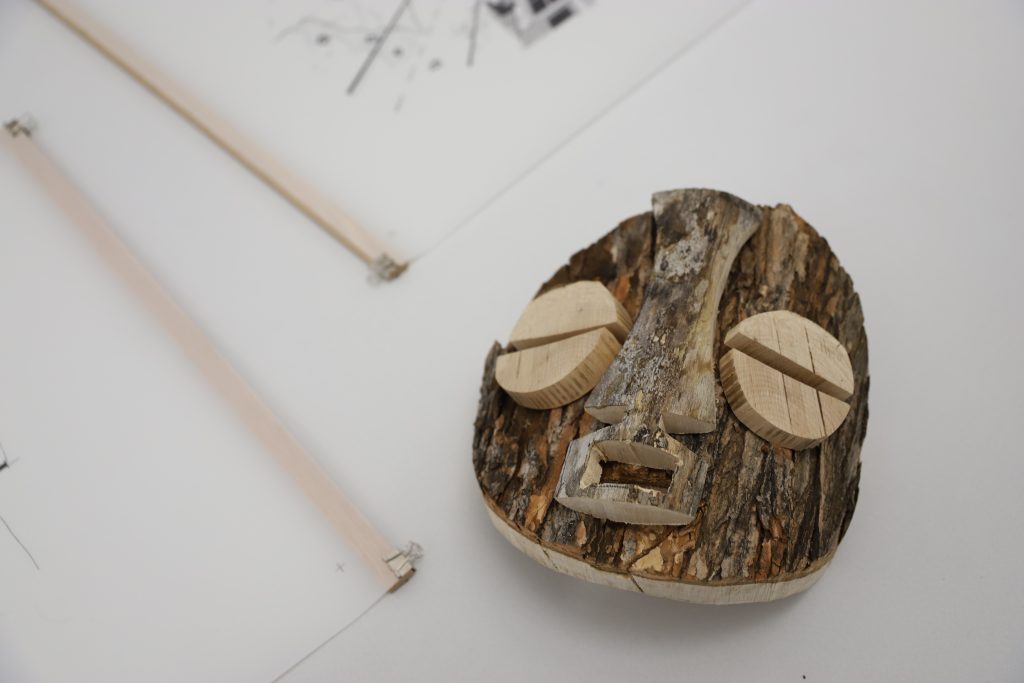What Is Taken Is Also What Is Received
March 14, 2021

Accompanying text
text by Kai Wood Mah
Generosity is seemingly common, yet its value is more elusive than simply sharing or gifting. This is particularly so when we participate in events together — to be involved with one another. In rethinking “generosity” and “participation,” two well-used words in recent discourse on co-creation, generally used to incite living together in politically and environmentally tumultuous times, the exhibit Partage/Partake sheds some light.
I brought together three artists of different backgrounds, histories and experiences, each working and living through translation of some sort — linguistically, culturally ― and with different relationships to Sudbury and Canada: born-and-raised in Sudbury; recent immigrant to Canada; and on an international student visa. As the mentor and curator of Partage/Partake, my instructions were broadly conveyed, allowing the three artists to envision the work.
I had initially relayed an idea to Andrei Aranyi regarding the imperfectness of “partage” and “partake”, these curiously different yet similar words, a difference of one letter, and across languages in French and English. “Partake,” thus, is an imperfectly perfect translation of partage, implying that a residual piece is kept in the act of exchange. How much does one take and/or give in creative and social exchanges? To what point does it matter what is mine or yours? Isn’t this what practically happens when we engage with one another? That the boundary of self and other is barely noticeable unless we imagine its existence?
One can see how Jonathan Kabumbe’s more literal masks are but one of many masks on display. He made four, one for each of us, asking us for something we value — as masks in Kabumbe’s native Congolese culture express what one holds dear and close. It expresses the good, the face unhidden as would commonly be expected behind a mask; it externalizes the self in its readiness to give.
Using drawings, Jennie Philipow receives her mask and ours, and in turn creates masks of another sort. To make her mask, Kabumbe used a flour sack, inferring the old French town in Sudbury, Flour Mill or Moulin à Fleur, which dates back to the end of the nineteenth century when Franco-Ontarians built housing on the Jesuit-owned land. In making her drawings, Philipow takes as she readily receives, and then, gives to the relay of interpretations, opening to personal experiences of place.
If parts of Kabumbe’s masks were taken into Philipow’s drawings, then Aranyi’s site-specific installation envelopes the GNO’s temporary space, along with the objects and visitors. The room-within-a-room is made of meticulously stretched fabric inside the borrowed space. It blurs the ceiling acoustic tiles, the surface-mounted fluorescent lighting fixtures, the doorways and frames, the gray carpet — all the materials of an office space, not a gallery. Inside, the senses are muffled, everything is blurred. So are the sounds of the mingling of visitors engaging with one another as they pick up Kabumbe’s masks and peer over the details of Philipow’s ink drawings, pointing at familiar locations of their city.
The show came together as a collective installation only later on in the process of development and exchange. Aranyi relayed the idea of Partage/Partake to Kabumbe, who then talked to Philipow. They talked, worked, made, and the outcome of the three pieces activated a circuitry of events, communities, objects, spaces, environments. At the end, the installation is co-created, co-authored. But the inseparable attachment of the pieces to one another only came about when the management of proprietary and nonproprietary was no longer viable. Initially, the three artists devised a framing strategy to allow work to be shown in more or less a group show format, but at some point Partage/Partake slowly seeped in. It was unattainable or even practical to have a group show. Philipow’s drawings and Kabumbe’s masks had to be inside Aranyi’s piece. Philipow was in Vancouver and had our conversations communicated to her by Kabumbe and Aranyi. She had to send her drawings and Aranyi arranged to have them scaled, printed, and mounted. The cultural use of Kabumbe’s mask had to be adapted to all of us. What was taken was received and at the end, each had something of one another.
One might say Partage/Partake heightens the perceptual field in seeing a mining city that, in the throes of going about its ways, has forgotten to look and see the vestiges, like GNO’s temporary space in one of the few early twentieth-century buildings in Sudbury. This northern mining city is no different than other cities in regards to urban change, but Partage/Partake speaks to social change and the irrationality of ownership underlying what is yours and what is mine. In our exchange, we are taking as much as we are receiving. The difference between people is merely imagined, and perhaps we are less hidden in the presence of one another than we might think, or that we might be part of one another more than we might have yet imagined.
